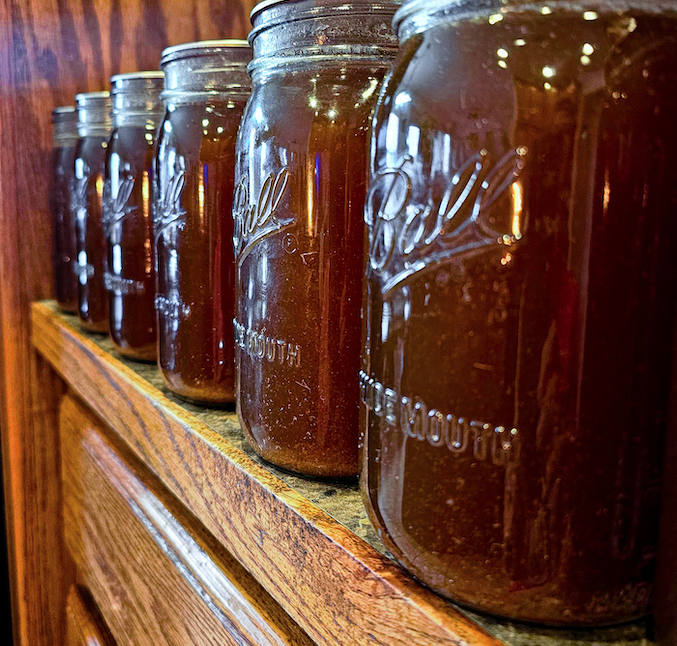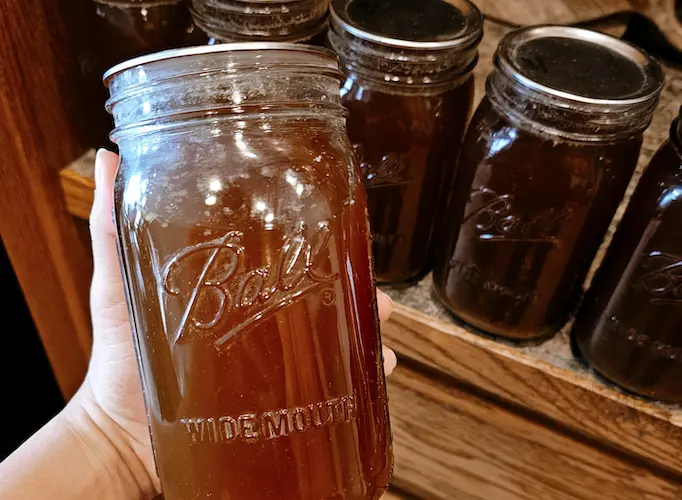I have been making and preserving my own stocks and bone broths for several years now. Like most individuals, I have been seeking natural remedies and nourishing options to support self-sufficiency and overall well-being. The popularity of bone broth has soared, becoming a focal point of discussions among health enthusiasts, chefs, and wellness experts alike. I have even seen bone broth “fasts” and suggestions for the use of warm broth as a substitute for coffee in the mornings.
Bone broth can be consumed alone; however, I normally use it as an additive to many dishes. This article embarks on an exploration of the benefits of bone broth. By examining its benefits, offering a detailed recipe, and exploring preservation techniques, my aim is to provide a comprehensive guide for individuals interested in adding the beneficial elements of bone broth in their everyday lives.
Health Benefits of Bone Broth
Bone broth is a nutrient-rich powerhouse! Bone Broth has a multitude of vital elements, including collagen, gelatin, and an array of essential minerals. Collagen and gelatin, derived from the connective tissues and bones simmered in the broth, provide the building blocks for healthy joints, skin, hair, and nails. Additionally, the slow extraction process helps extract crucial minerals like calcium, magnesium, phosphorus, and potassium from the bones. These elements contribute significantly to overall bodily functions, supporting metabolic processes, nerve function, and muscle health.
The abundance of nutrients in bone broth offers a range of benefits for your personal health. The presence of minerals in bone broth, such as calcium and magnesium, not only improves bone structure but also aids in muscle function and helps regulate blood pressure. Beyond its impact on joint and bone health, bone broth plays a pivotal role in enhancing gut health and bolstering the immune system. The gelatin in bone broth supports the integrity of the intestinal lining, promoting gut health and potentially alleviating digestive issues. Moreover, the amino acids derived from collagen may help support the immune system by assisting in the production of antibodies, strengthening the body’s defense mechanisms against pathogens.
Healing Properties and Other Benefits
The standard American diet produces so much internal inflammation. So, one of the most compelling attributes of bone broth lies in its potential healing properties, notably its reported anti-inflammatory effects. Compounds presented in bone broth possess anti-inflammatory properties that could aid in reducing inflammation throughout the body. Bone broth’s remarkable potential to aid in digestion and improve gut health cannot be understated. The gelatin and amino acids in bone broth support the lining of the digestive tract, potentially reducing intestinal inflammation and contributing to improved digestion. Additionally, this nurturing effect on the gut lining helps by promoting gut integrity and supporting the growth of beneficial gut bacteria. The collagen and amino acids derived from bone broth may promote healthier skin and hair.
Bone broth is often regarded as a potential aid in weight management due to its high protein content and satiating properties. Consuming bone broth as part of a balanced diet may promote feelings of fullness, potentially reducing overall calorie intake and aiding in weight loss or weight management goals.

Bone Broth Recipe
Stock vs. Broth what is the difference between the two? They are almost the same recipe. Stocks are made with the bones only. Broth the bones still contain flesh and tendons. Both can be cooked with vegetables, however, typically stocks are left unseasoned.
Ingredients:
- 2-3 pounds of raw beef bones (with marrow and connective tissues, if possible)
- 1-2 onions, roughly chopped
- 2-3 carrots(peeled), roughly chopped
- Salt and whole peppercorns to taste
- 3-5 bay leaves
- Water
- 1/3 to 1/2 cup of vinegar (distilled or apple cider)
Instructions:
Part 1- Preparation:
- Step 1- Preheat a roaster oven to 250°F (120°C).
- Step 2- Place the raw beef bones, chopped onions, carrots, salt, peppercorns, bay leaves, and vinegar into the roaster oven. Adjust seasoning according to preference.
- Step 3- Fill the roaster oven with water until full and the ingredients are fully submerged.
Note: Seasoning and vegetables are optional; they add flavor but can be omitted. Some people do not want seasoned bone broth because they aren’t sure how it will be used later. I normally always use this basic seasoning. You can adjust the ingredients, seasoning, and cooking time based on personal preferences for taste and richness.
** The addition of vinegar acts as an acid to aid in breaking down the bones and extracting essential vitamins and nutrients into the broth.
Part 2. Simmering:
- Step 4- Cover the roaster oven and let it cook at 250°F for a minimum of 24-48 hours. Occasionally stir the broth to ensure even cooking and flavor distribution.
- Step 5- The low heat and extended cooking time help break down the bones and release nutrients into the broth.
Part 3. Straining and Cooling:
- Step 6- After 24-48 hours, turn off the roaster oven and carefully strain the broth using a fine-mesh strainer or cheesecloth into large bowls.
- Step 7- If you have a fat separator move on to the next step, if not continue to the refrigeration process.
- Step 8- Allow the strained broth to cool at room temperature for a while, then transfer it to the refrigerator.
- Step 9- Once the broth has cooled sufficiently, a layer of fat may solidify on the surface. Skim off the fat using a spoon or ladle.
Note: I remove the fat from my broth because I want a more “pure finish” bone broth. However, it is not necessary to do so and comes down to personal preference.
@bethanybeathard Beef Bone broth is a powerhouse of nutrients! Be sure to check @Everest | Curated Outdoor Gear for this months recipe and guide on bone broth. #bonebroth #foodpreservation #foodisnutrition #Everest #homemade #canning ♬ original sound – Bethany Beathard
Preservation Methods
Below is a brief overview of some food preservation methods for your bone broth. Learning to properly preserve food takes time and is a useful skill.
Refrigeration
Bone Broth can be immediately stored in the refrigerator for up to 4-5 days. Pour broth into a sealed container. If there are a traces of fat remaining, you may notice floating pieces of solid fat or even a jelly-like substance occurs. Those particles will dissipate when you reheat the broth.
Freezing
Alternatively, freeze the broth for longer storage. You can freeze flat in vacuum sealed bags, freezer Ziploc bags or in freezer-safe glass jars or plastic containers. Ensure the containers are freezer-safe and seal well. If using glass jars use jars that at straight with no shoulder. Allow at least 1” of headspace to allow for swelling, especially in glass jars because they are prone to breaking. When I use glass, I allow them to fully freeze before tightening the lids. Typically, frozen broth has a shelf life of 6-12 months depending on the method used. However, I have read some hot pack techniques could remain good for 24 months.
Canning
Pressure canning is the method required for bone broth. Due to its low acidity, the use of a pressure canner is needed to preserve the broth properly and safely. Pressure canning is a whole process in itself, it is really a science. Though intimidating, with time it becomes easier to do.
Prepare the bone broth according to your preferred recipe and let it cool to room temperature.
- Sterilize your canning jars, lids, and rings by boiling them for 10 minutes.
- Fill the bone broth into the sterilized canning jars, leaving the recommended headspace 1 inch.
- Wipe the jar rims clean with vinegar, place the lids on top, and screw on the rings until fingertip tight.
- Follow your pressure canner’s instructions for setting up the canner, adding water according to specifications, and placing the filled jars inside.
- Close and lock the pressure canner lid, following the manufacturer’s guidelines for sealing and pressurizing.
- Process the bone broth jars at the recommended pressure and duration as specified in the pressure canner’s manual based on your altitude and the type of broth.
- Once processing is complete, turn off the heat and allow the pressure canner to depressurize naturally.
- Carefully remove the jars from the canner using jar lifters and place them on a towel or cooling rack.
- Allow the jars to cool completely, check the seals, wash jars, label with the date, and store.
Remember, these steps provide a general overview, and it’s crucial to refer to the specific instructions provided in your pressure canner’s manual for accurate and safe canning procedures, including processing times and pressures based on your location’s altitude and the type of broth being canned. Safety measures and guidelines from the manufacturer should always be followed when using a pressure canner. Like I stated before, this is a science and needs to be preformed correctly for a safe consumable product.
Bone broth stands as a nutritional powerhouse, offering a multitude of health benefits that extend beyond traditional culinary appreciation. Its diverse array of nutrients and healing properties render it a valuable addition to one’s dietary regimen, contributing to overall health and well-being. Regardless of how you choose to preserve it, bone broth makes a flavorful addition for several dishes.









